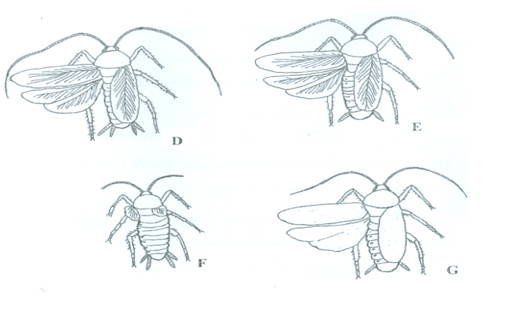Question 2
-
Diagrams D, E, F and G are illustration of organisms of the same species. Study them and answer questions 2(a) to (h).
- Name the:
(i) Phylum
(ii) Class of the organisms. [2 marks]
- Give two reasons each for the answers in 2 (a)
(i) Phylum [2 marks]
(ii)Class [2 marks]
(i) Which of the organisms are male? [2 marks]
(ii) Give one reason for the answer in (c)(i). [1 mark]
- State three observable differences between organisms D and G.
- State one observable biological advantage each that:
(i) D has over F; [2 marks]
(ii) F has over D. [2 marks]
- State four observable features that show variation in organisms D, E, F and G.[4 marks]
- Suggest two possible habitats of the organism. [2 marks]
- (State three ways in which the organisms are of economic importance. [3 marks]

Observation
Most candidates could not name the phylum and class of the organism illustrated, while many candidates mixed up the reasons for the classification of the organism into phylum and class. Majority of candidates started the answer to (a) (i) with small letters while some could not spell the names correctly which made them lose the marks.
Question (c)(i) was well answered by many candidates but they could not answer (c)(ii) as many of them could not state the reason the organism is male. Many candidates were able to answer (d) properly. Questions (e) and (f) were not properly answered while (g) and (h) were answered better.
The expected answers are:
1.(a) (i) Phylum
Arthropoda
(ii) Class
Insecta
(b) Reasons for
Phylum
- Metameric segmentation;
- Possession of chitinous cuticle/exoskeleton;
- Possession of jointed appendages.
Class
- Presence of a pair of antennae;
- Presence of one pair of compound eyes;
- Presence of three body divisions/head, thorax, abdomen;
- Presence of three pairs of legs (on thorax; one pair per segment).
(c) (i)Organisms that are male
D; F
(ii)Reason
Presence of anal style.
(d) Observable differences between D and G
![]()
(e) Observable biological advantage that:
D has over F
- D has wings to fly/escape predators while F has undeveloped wings and cannot fly;
- D has longer antennae than F for better sensitivity;
- D has wings to protect the abdomen while F has wing stubs which cannot protect the abdomen;
- D has a pair of visible compound eyes for vision while F has no visible eyes.
F has over D
- F has a small body/size to hide in small places to escape danger;
- F has spiracles for breathing while spiracles are not visible in D.
Note: Structure must correspond to function to score.
(f) Observable features that show variation in organisms D, E, F and G
- Antenna (length);
- Wing (length);
- Wing venation;
- Body size/size of abdomen;
- Presence/absence of anal styles;
(g) Habitats
- Dark corners of rooms;
- boxes/cupboards;
- crevices/cracks in walls;
- soak away/septic tanks;
- pit toilet/latrines;
- litter/waste bins.
(g) Economic importance
- Destroys materials in the home/shoes/clothes/books e.t.c.;
- Distributes/transmits dirt/contaminates food;
-- Carries germs/parasites/vectors of diseases/dysentery/leprosy/cholera/tuberculosis/typhoid;
- Their repulsive odour/foul smell makes them a nuisance;
- Their faeces stain clothes/books.
